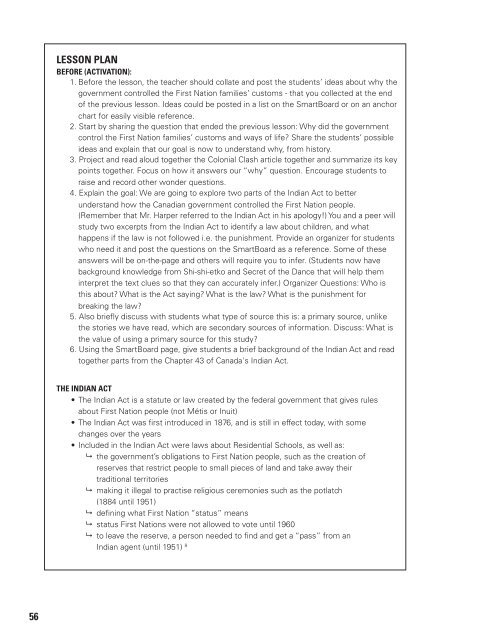Residential Residential
Residential_School
Residential_School
You also want an ePaper? Increase the reach of your titles
YUMPU automatically turns print PDFs into web optimized ePapers that Google loves.
LESSON PLAN<br />
BEFORE (ACTIVATION):<br />
1. Before the lesson, the teacher should collate and post the students’ ideas about why the<br />
government controlled the First Nation families’ customs - that you collected at the end<br />
of the previous lesson. Ideas could be posted in a list on the SmartBoard or on an anchor<br />
chart for easily visible reference.<br />
2. Start by sharing the question that ended the previous lesson: Why did the government<br />
control the First Nation families’ customs and ways of life? Share the students’ possible<br />
ideas and explain that our goal is now to understand why, from history.<br />
3. Project and read aloud together the Colonial Clash article together and summarize its key<br />
points together. Focus on how it answers our “why” question. Encourage students to<br />
raise and record other wonder questions.<br />
4. Explain the goal: We are going to explore two parts of the Indian Act to better<br />
understand how the Canadian government controlled the First Nation people.<br />
(Remember that Mr. Harper referred to the Indian Act in his apology!) You and a peer will<br />
study two excerpts from the Indian Act to identify a law about children, and what<br />
happens if the law is not followed i.e. the punishment. Provide an organizer for students<br />
who need it and post the questions on the SmartBoard as a reference. Some of these<br />
answers will be on-the-page and others will require you to infer. (Students now have<br />
background knowledge from Shi-shi-etko and Secret of the Dance that will help them<br />
interpret the text clues so that they can accurately infer.) Organizer Questions: Who is<br />
this about? What is the Act saying? What is the law? What is the punishment for<br />
breaking the law?<br />
5. Also briefly discuss with students what type of source this is: a primary source, unlike<br />
the stories we have read, which are secondary sources of information. Discuss: What is<br />
the value of using a primary source for this study?<br />
6. Using the SmartBoard page, give students a brief background of the Indian Act and read<br />
together parts from the Chapter 43 of Canada's Indian Act.<br />
THE INDIAN ACT<br />
• The Indian Act is a statute or law created by the federal government that gives rules<br />
about First Nation people (not Métis or Inuit)<br />
• The Indian Act was first introduced in 1876, and is still in effect today, with some<br />
changes over the years<br />
• Included in the Indian Act were laws about <strong>Residential</strong> Schools, as well as:<br />
9 the government’s obligations to First Nation people, such as the creation of<br />
reserves that restrict people to small pieces of land and take away their<br />
traditional territories<br />
9 making it illegal to practise religious ceremonies such as the potlatch<br />
(1884 until 1951)<br />
9 defining what First Nation “status” means<br />
9 status First Nations were not allowed to vote until 1960<br />
9 to leave the reserve, a person needed to find and get a “pass” from an<br />
Indian agent (until 1951) 8<br />
56


